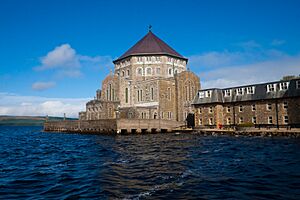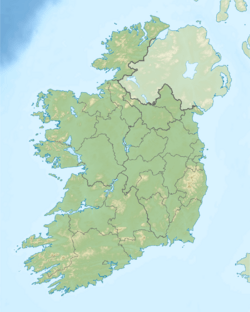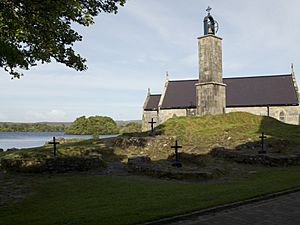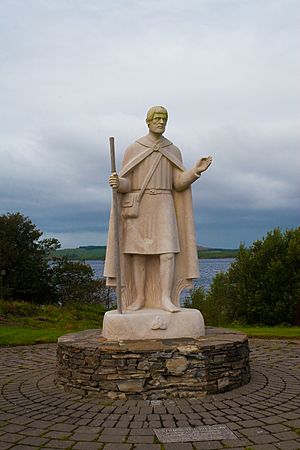St Patrick's Purgatory facts for kids
Quick facts for kids Saint Patrick's Basilica |
|
|---|---|
| St Patrick's Purgatory | |
|
Baisleac Naomh Pádraig
|
|
 |
|
| 54°36′32.30″N 7°52′16.51″W / 54.6089722°N 7.8712528°W | |
| Location | Lough Derg, County Donegal |
| Country | Ireland |
| Language(s) | English, Irish, Latin |
| Denomination | Catholic |
| Tradition | Roman Rite |
| History | |
| Status | minor basilica |
| Dedication | Saint Patrick |
| Dedicated | 12 May 1931 |
| Architecture | |
| Architect(s) | William Alphonsus Scott Thomas Joseph Cullen |
| Style | Romanesque Revival, Neo-Byzantine |
| Groundbreaking | 1924 |
| Completed | 1931 |
| Construction cost | IR£80,000 |
| Specifications | |
| Materials | ashlar, stone, marble, lead, stained glass, copper, concrete |
| Administration | |
| Diocese | Clogher |
St Patrick's Purgatory is a very old pilgrimage site in Ireland. It is found on Station Island in Lough Derg, County Donegal. People have been visiting this special place for many centuries.
According to an old story, the site began in the 400s. This was when Saint Patrick was said to have been shown a cave by Christ. This cave, sometimes called a pit or a well, was believed to be an entrance to Purgatory.
This site was very important in the Middle Ages. It was mentioned in writings as early as 1185. It even appeared on maps from all over Europe by the 1400s. It is the only Irish place shown on Martin Behaim's world map from 1492.
Contents
Where is St Patrick's Purgatory Located?
St Patrick's Purgatory is on Station Island. This island is in Lough Derg, County Donegal. There was some confusion in the 1800s about its exact spot. Some maps mistakenly placed it on Saints Island.
However, old documents clearly show it on Station Island. For example, a detailed map from 1666 calls it "Caverna Purgatory." This map is in a book by Fr. Thomas Carve.
How the Site Began
The Legend of Saint Patrick
The legend says that St. Patrick was trying to teach people about God. But they wanted proof. St. Patrick prayed for help. God then showed him a pit in the ground. He called it Purgatory.
By showing this place, people would believe his teachings. They would understand the joys of heaven and the pains of hell.
St. Dabheog's Connection
There is no proof that St. Patrick visited Lough Derg. This legend likely started around the 1100s. However, there is a stronger tradition about St. Dabheog. He was a local abbot. He probably led the monastery on the island during St. Patrick's time.
St. Dabheog's name is linked to several places nearby. These include St. Dabheoc's Chair and Seadavog Mountain. One of the islands in Lough Derg was also named after him.
The Mysterious Cave
The cave was closed on October 25, 1632. But we have descriptions from early visitors. They called it a cave, cellar, or enclosed pit. The entrance was small, about 0.6 meters (2 feet) wide and 0.9 meters (3 feet) high.
Inside, there were about six steps down. The cave had two parts. The first part was about 3 meters (9 feet) long. It was only high enough to kneel in. After a turn, there was another small area about 1.5 meters (5 feet) long.
What Was the Cave Used For?
The site has never been dug up by archaeologists. So, we rely on these old descriptions. It was likely an ancient structure. Some think it was a souterrain. This is a place for storing crops or animals. But the cave was too small for that.
A more likely idea is that it was an ancient sweat house. These were still used in Ireland until the 1900s. People would go into these small, enclosed places. They would breathe in smoke from burning plants. This was for healing.
The name "purgatorium" might have meant a place for cleansing. It could have been like a modern sauna. The idea of "purgatory" as a place for punishment after death became common later, around the 1200s. So, the cave might have been a place for physical or spiritual healing. This was true even before it was linked to St. Patrick in the 1100s.
The Monastery and Its Purpose
A monastery likely existed on the islands in Lough Derg from the 400s. It probably had anchorites. These were people who lived alone in small, beehive-shaped cells. Some of these cells might be preserved in the "penitential beds" seen on Station Island today.
Around 1130, the monastery was given to Augustinian Canons Regular. This was done by the church in Armagh. The monastery on Saints Island welcomed pilgrims. They came to pray and show their devotion. It also helped pilgrims get ready to visit the Purgatory.
Pilgrims who wanted to visit the Purgatory needed permission letters from a bishop. They would then spend fifteen days fasting and praying. This prepared them for the short boat trip to Station Island. After fifteen days, they would confess their sins and receive communion. Then, they would be locked in the cave for twenty-four hours. The next morning, if they were alive, they would return to Saints Island. There, they would spend another fifteen days praying and fasting.
Pilgrims from Far Away
From the time of St. Dabheoc, this area attracted pilgrims from many places. By the 1100s, they came from all over Europe. They likely sailed from England. Then, they landed at Dublin or Drogheda. From there, they walked across Ireland. This journey probably took two weeks. They would stop at monasteries along the way.
Many sinners and criminals were sent on pilgrimages. This was to make up for their actions and seek forgiveness. St. Patrick's Purgatory was a common destination for these pilgrims. Communities of anchorites were thought to have special power to forgive them.
The Medieval Pilgrimage Route
We can trace the medieval pilgrimage route from a description by Guillebert of Lannoy. He was a pilgrim in the 1400s. In 1430, he reported traveling from Drogheda to Kells. This route followed the Boyne River. He likely stopped at places like Mellifont, Slane, and Donaghmore. He stayed at monasteries, which was common for travelers then.
From Kells, he went northwest toward Enniskillen. He called it Rousseaumoustier. A duke lent him a boat there. He and his friends traveled up Lough Erne. They probably stopped at islands like Devenish and White Island. Along this path, he would have also passed the important monastery of Drumlane.
Changes in the 1400s
A new idea about the pilgrimage's first "closure" was presented in 2017. It was thought to have happened in the late 1400s. Some documents claimed a Dutch monk accused the pilgrimage organizers of simony. This means selling church positions or favors.
However, some believe this document was a fake. It might have been written by someone who had never visited Lough Derg. They might have confused it with St Patrick's Well in Italy. The Pope would not have ordered the pilgrimage to close. The documents say the "cave...was broken" and "that site of fallacy" was destroyed. This suggests a false cave was destroyed, not the entire pilgrimage.
According to one theory, Cathal Óg Mac Maghnusa wanted to change the pilgrimage. He was a bishop in the Roman Catholic Diocese of Clogher. He wanted to make it more about penance. The idea of a journey to the underworld could not continue. To make this change, a fake Papal order might have been created.
The monastery was officially closed in 1632. But local lords allowed the monks to stay. By 1710, Franciscans were on the island in summer. They helped the pilgrims. They built a church, St. Mary of the Angels, in 1763. In 1785, the Roman Catholic Diocese of Clogher took over Station Island. In 1960, Shane Leslie gave ownership of the island to the diocese.
Modern Pilgrimage Experience
The pilgrimage to St. Patrick's Purgatory has continued for over 1500 years. It has never stopped. Each year, the main pilgrimage season starts in late May or early June. It ends in mid-August, on the 15th. This is the feast of the Assumption of Mary.
Who Can Go?
People of all religions, or none, can go. Pilgrims must be at least fifteen years old. They need to be in good health. They must be able to walk and kneel without help.
What Happens?
Pilgrims start fasting the night before. They gather at the Visitor Centre on the shore of Lough Derg. A boat takes them to Station Island. Once there, they get a dormitory room. They walk barefoot. They follow a continuous cycle of prayer and church services.
These prayers include the Our Father, the Hail Mary, and the Apostles' Creed. They are done at special 'stations' on the island. These include six 'beds'. These beds are the remains of ancient cells or beehive huts. They are named after famous saints. These are thought to be very old monastic cells.
Pilgrims spend the first night praying in the island's basilica. They can finally sleep in the dormitory on the second night. Each day, they have one simple meal. It includes dry toast, oatcakes, and black tea or coffee. On the third morning, they return to the mainland. They continue their fast until midnight.
Other Programs and Facilities
Other programs are offered throughout the year. These include Quiet Days, Family Days, and One-Day Retreats. The site is managed by the Roman Catholic Diocese of Clogher. Staff are available to help with spiritual and practical needs. There is a kitchen, laundry, first-aid station, and a book/gift shop.
The pilgrimage did not happen in 2020 or 2021. This was due to the COVID-19 pandemic in Ireland. It reopened in 2022. A "Pilgrim Shelter Museum" was a new addition.
Literature and Creative Works
Many books and poems have been written about St Patrick's Purgatory.
- Tractatus de Purgatorio Sancti Patricii is a 12th-century Latin story about a pilgrimage.
- Marie de France translated it into French. She expanded it into the Legend of the Purgatory of St. Patrick.
- A play about the shrine was written by Spanish poet Pedro Calderon de la Barca.
- Other medieval works include The Knight of Hungary and The Vision of Louis of France.
- Sir James Ware, a historian, described the cave in his 1654 book De Hibernia.
More recent works include:
- Station Island is a long poem by Séamus Heaney. It is about his pilgrimage experience.
- Other poets like Denis Devlin and Patrick Kavanagh also wrote about it.
- "The Lough Derg Pilgrim" by William Carleton tells his story. His visit led him to change his religious path.
- Pete McCarthy described his 1998 visit in McCarthy's Bar.
- Froissart's Chronicles mentions the site in Book Four.
- Rabelais's Gargantua jokingly refers to it.
- 'The Pilgrim' by W. B. Yeats focuses on the pilgrimage.
Pilgrims Over Time
Records before 1632 were destroyed. So, we don't know how many pilgrims visited each year then. But records after that time are available.
- In 1700, 5,000 pilgrims were recorded.
- By 1826, the number grew to 15,000.
- It reached 30,000 by 1846, just before the Great Famine.
- From 1871 to 1903, about 3,000 pilgrims visited yearly.
- From 1908 to 1921, the average was over 8,000.
- From 1929 to the end of the 1900s, the number was never below 10,000. Many years it was two or three times that.
- In 2011, 8,000 people completed the pilgrimage.
Famous Pilgrims
Some notable people who have visited include:
- Georgius Ungarus, a knight from Hungary.
- Malatesta Ungaro, an Italian leader.
- Laurence Rathold of Pászthó, a courtier from Hungary.
- Jan I van Brederode, a Dutch count's vassal, visited in 1399.
- Guillebert de Lannoy, a knight from Burgundy, made the pilgrimage in 1430.
- Francesco Chiericati, a papal representative, visited in 1522.
- Mary McAleese – a former President of Ireland.
- Frank Duff – Founder of the Legion of Mary.
- Seamus Heaney – a famous poet.
We know the names of thirty-three pilgrims between about 1146 and 1517. Most are listed in a book by Haren and de Pontfarcy. Francesco Chiericati saw the name of the 33rd, Guarino da Durazzo, in a book on Station Island during his visit. All records on St. Patrick's Purgatory were supposedly destroyed on October 25, 1632.
See also
 In Spanish: Purgatorio de San Patricio para niños
In Spanish: Purgatorio de San Patricio para niños






